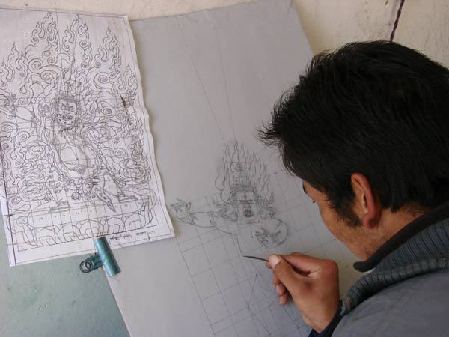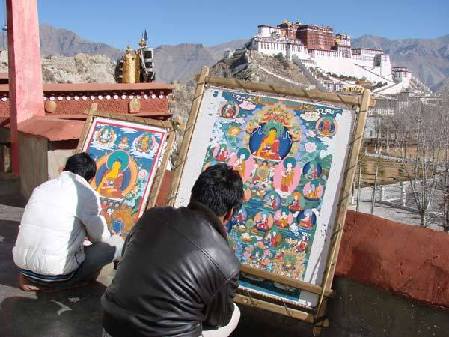Holy mission to carry forward Tibetan Thangka
"I treat my students as my own children and teach them how to paint thangka for free, I think it' s my destiny to carry forward this Tibetan traditional art form," said Tibetan thangka painter Norbu Sida.
"I hope more and more youngsters could fall in love with it," he added.
Norbu Sida who was born in 1967 in Xigaze, began to learn painting thangka as a nine-year-old boy. With more than 30 years of drawing experience, he has been selected as thangka successor by The Tibet Autonomous Region (TAR) in 2008.
Thangka: the most wonderful pearl on the crown of Tibetan art
A Tangka (a Tibetan word meaning "silk, satin or cloth painting scroll") is created with the intention of showing a painting to the public. This art form has been brought into the first group of national list of intangible cultural heritage in 2006.
Norbu Sida sketches line drawings, which is the first step to paint a thangka.
|
 Norbu Sida sketches line drawings, which is the first step to paint a thangka. [CnDG] |
The content of most thangkas is usually images of Buddha or a reflection of lift stories of eminent monks and folk customs. The painting methods utilize mainly bright colors and line drawings.
Norbu explained that all of the pigments are made from natural minerals. For example, the golden color is produced from gold and the green color is from turquoise. It could spend months to make these pigments with strict procedure by hand. And the colors will not fade, even for hundred years.
|
 Norbu's students practice painting thangka in the art center, nearby Potala Palace. [CnDG] |
"It will take half a year, even a whole year to complete an exquisite thangka."
"I would hold breath to draw every stroke in the most delicate part of the painting. It needs complete concentration and you cannot make any mistakes at all," he said proudly.
Urgent task to cultivate more young painters
At present, Norbu runs a thangka art center at the foot of Yaowangshan Mountain, nearby Potala Palace. He recruited children from Tibetan rural areas aged from nine to 12. Then he trained them how to paint thangka from the basic line drawing to complicated layout.
He has 18 students right now; the oldest one has graduated and helps him to manage the art center.
At the mention of his funding source, he explained that the money to maintain the daily operation of the art center and his students' spending were all supplied from his earnings selling his paintings.
"I'm willing to accept any donations and help from warm-hearted men. If I have enough money, I will enroll more Tibetan students to learn and promote this traditional art," he said.He believes it’s an urgent task to attract more young Tibetans to learn it with earnest attitude, because it's a handicraft with thick Tibetan cultural sediments.


















